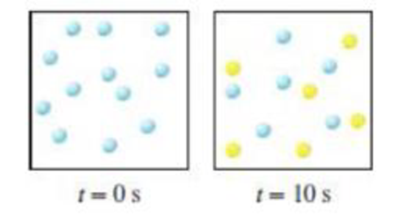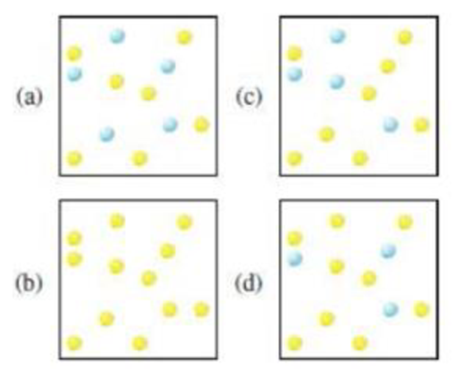
GEN COMBO CHEMISTRY: ATOMS FIRST; ALEKS 360 2S ACCESS CARD CHEMISTRY:ATOMS FIRST
3rd Edition
ISBN: 9781260020229
Author: Julia Burdge
Publisher: McGraw-Hill Education
expand_more
expand_more
format_list_bulleted
Textbook Question
Chapter 19, Problem 19.36QP
Consider the first-order reaction A → B in which A molecules (blue spheres) are converted to B molecules (yellow spheres). The figure shows the progress of the reaction after 10 s.

Which figure represents the number of molecules present after 20 s for the previous reaction?

Expert Solution & Answer
Want to see the full answer?
Check out a sample textbook solution
Students have asked these similar questions
When two solutions, one of 0.1 M KCl (I) and the other of 0.1 M MCl (II), are brought into contact by a membrane. The cation M cannot cross the membrane. At equilibrium, x moles of K+ will have passed from solution (I) to (II). To maintain the neutrality of the two solutions, x moles of Cl- will also have to pass from I to II. Explain this equality: (0.1 - x)/x = (0.1 + x)/(0.1 - x)
Calculate the variation in the potential of the Pt/MnO4-, Mn2+ pair with pH, indicating the value of the standard potential. Data: E0 = 1.12.
Given the cell: Pt l H2(g) l dis X:KCl (sat) l Hg2Cl2(s) l Hg l Pt. Calculate the emf of the cell as a function of pH.
Chapter 19 Solutions
GEN COMBO CHEMISTRY: ATOMS FIRST; ALEKS 360 2S ACCESS CARD CHEMISTRY:ATOMS FIRST
Ch. 19.3 - Prob. 19.1WECh. 19.3 - Write the rate expressions for each of the...Ch. 19.3 - Write the balanced equation corresponding to the...Ch. 19.3 - The diagrams represent a system that initially...Ch. 19.3 - Consider the reaction 4NO2(g)+O2(g)2N2O5(g) At a...Ch. 19.3 - Consider the reaction 4PH3(g)P4(g)+6H2(g) At a...Ch. 19.3 - Prob. 2PPBCh. 19.3 - Prob. 2PPCCh. 19.3 - Prob. 19.3.1SRCh. 19.3 - Prob. 19.3.2SR
Ch. 19.4 - The gas-phase reaction of nitric oxide with...Ch. 19.5 - Calculate the rate constant for the first-order...Ch. 19.5 - Prob. 19.7WECh. 19.5 - The reaction 2A B is second order in A with a rate...Ch. 19.5 - Prob. 7PPBCh. 19.5 - Prob. 19.5.4SRCh. 19.7 - Prob. 19.11WECh. 19.7 - Prob. 11PPACh. 19.7 - Prob. 11PPBCh. 19.7 - Consider the gas-phase reaction of nitric oxide...Ch. 19.7 - Prob. 12PPBCh. 19 - The rate of a reaction in which the reactant...Ch. 19 - The rate of a reaction in which the reactant...Ch. 19 - The rate of a reaction in which the reactant...Ch. 19 - Increasing the temperature of a reaction increases...Ch. 19 - Define activation energy. What role does...Ch. 19 - Sketch a potential energy versus reaction progress...Ch. 19 - The reaction H + H2 H2 + H has been studied for...Ch. 19 - What is meant by the rate of a chemical reaction?...Ch. 19 - Distinguish between average rate and instantaneous...Ch. 19 - What are the advantages of measuring the initial...Ch. 19 - Prob. 19.7QPCh. 19 - Consider the reaction N2(g)+3H2(g)2NH3(g) Suppose...Ch. 19 - Prob. 19.9QPCh. 19 - Prob. 19.10QPCh. 19 - Prob. 19.11QPCh. 19 - Prob. 19.12QPCh. 19 - Prob. 19.13QPCh. 19 - What are the units for the rate constants of...Ch. 19 - Consider the zeroth-order reaction: A product....Ch. 19 - Prob. 19.16QPCh. 19 - Prob. 19.17QPCh. 19 - Prob. 19.18QPCh. 19 - Prob. 19.19QPCh. 19 - Prob. 19.20QPCh. 19 - Prob. 19.21QPCh. 19 - Prob. 19.22QPCh. 19 - Prob. 19.23QPCh. 19 - Prob. 19.24QPCh. 19 - Prob. 19.25QPCh. 19 - Prob. 19.26QPCh. 19 - Prob. 19.27QPCh. 19 - Prob. 19.28QPCh. 19 - Prob. 19.29QPCh. 19 - Prob. 19.30QPCh. 19 - Prob. 19.31QPCh. 19 - The rate constant for the second-order reaction...Ch. 19 - Prob. 19.33QPCh. 19 - Consider the first-order reaction X Y shown here,...Ch. 19 - Prob. 19.35QPCh. 19 - Consider the first-order reaction A B in which A...Ch. 19 - Prob. 19.37QPCh. 19 - Prob. 19.38QPCh. 19 - Prob. 19.39QPCh. 19 - Prob. 19.40QPCh. 19 - Prob. 19.41QPCh. 19 - Prob. 19.42QPCh. 19 - Prob. 19.43QPCh. 19 - Prob. 19.44QPCh. 19 - Prob. 19.45QPCh. 19 - The rate at which tree crickets chirp is 2.0 102...Ch. 19 - Prob. 19.47QPCh. 19 - The activation energy for the denaturation of a...Ch. 19 - Variation of the rate constant with temperature...Ch. 19 - Prob. 19.50QPCh. 19 - Prob. 19.51QPCh. 19 - Prob. 19.52QPCh. 19 - Prob. 19.53QPCh. 19 - What is an elementary step? What is the...Ch. 19 - Prob. 19.55QPCh. 19 - Determine the molecularity, and write the rate law...Ch. 19 - What is the rate-determining step of a reaction?...Ch. 19 - Prob. 19.58QPCh. 19 - Prob. 19.59QPCh. 19 - Classify each of the following elementary steps as...Ch. 19 - Prob. 19.61QPCh. 19 - Prob. 19.62QPCh. 19 - Prob. 19.63QPCh. 19 - Prob. 19.64QPCh. 19 - Prob. 19.65QPCh. 19 - What are the characteristics of a catalyst?Ch. 19 - Prob. 19.67QPCh. 19 - Prob. 19.68QPCh. 19 - The concentrations of enzymes in cells are usually...Ch. 19 - Prob. 19.70QPCh. 19 - Prob. 19.71QPCh. 19 - Prob. 19.72QPCh. 19 - Prob. 19.73QPCh. 19 - Prob. 19.74QPCh. 19 - Prob. 19.75QPCh. 19 - In a certain industrial process involving a...Ch. 19 - Prob. 19.77QPCh. 19 - Prob. 19.78QPCh. 19 - Explain why most metals used in catalysis arc...Ch. 19 - Prob. 19.80QPCh. 19 - Prob. 19.81QPCh. 19 - Prob. 19.82QPCh. 19 - Prob. 19.83QPCh. 19 - Prob. 19.84QPCh. 19 - The bromination of acetone is acid-catalyzed. The...Ch. 19 - The decomposition of N2O to N2 and O2 is a...Ch. 19 - Prob. 19.87QPCh. 19 - Prob. 19.88QPCh. 19 - The integrated rate law for the zeroth-order...Ch. 19 - Prob. 19.90QPCh. 19 - Prob. 19.91QPCh. 19 - Prob. 19.92QPCh. 19 - The reaction of G2 with E2 to form 2EG is...Ch. 19 - Prob. 19.94QPCh. 19 - Prob. 19.95QPCh. 19 - Prob. 19.96QPCh. 19 - Strictly speaking, the rate law derived for the...Ch. 19 - Prob. 19.98QPCh. 19 - The decomposition of dinitrogen pentoxide has been...Ch. 19 - Prob. 19.100QPCh. 19 - Prob. 19.101QPCh. 19 - Prob. 19.102QPCh. 19 - To prevent brain damage, a standard procedure is...Ch. 19 - Prob. 19.104QPCh. 19 - Prob. 19.105QPCh. 19 - Prob. 19.106QPCh. 19 - Prob. 19.107QPCh. 19 - Prob. 19.108QPCh. 19 - Prob. 19.109QPCh. 19 - Prob. 19.110QPCh. 19 - (a) What can you deduce about the activation...Ch. 19 - Prob. 19.112QPCh. 19 - Prob. 19.113QPCh. 19 - Prob. 19.114QPCh. 19 - Prob. 19.115QPCh. 19 - Prob. 19.116QPCh. 19 - Prob. 19.117QPCh. 19 - Prob. 19.118QPCh. 19 - Prob. 19.119QPCh. 19 - Prob. 19.120QPCh. 19 - Prob. 19.121QPCh. 19 - Prob. 19.122QPCh. 19 - Consider the following potential energy profile...Ch. 19 - Prob. 19.124QPCh. 19 - Prob. 19.125QPCh. 19 - Prob. 19.126QPCh. 19 - Prob. 19.127QPCh. 19 - Prob. 19.128QPCh. 19 - The following expression shows the dependence of...Ch. 19 - Prob. 19.130QPCh. 19 - The rale constant for the gaseous reaction H2(g) +...Ch. 19 - Prob. 19.132QPCh. 19 - Prob. 19.133QPCh. 19 - At a certain elevated temperature, ammonia...Ch. 19 - Prob. 19.135QPCh. 19 - The rate of a reaction was followed by the...Ch. 19 - Prob. 19.137QPCh. 19 - Prob. 19.138QP
Knowledge Booster
Learn more about
Need a deep-dive on the concept behind this application? Look no further. Learn more about this topic, chemistry and related others by exploring similar questions and additional content below.Similar questions
- The decimolar calomel electrode has a potential of 0.3335 V at 25°C compared to the standard hydrogen electrode. If the standard reduction potential of Hg22+ is 0.7973 V and the solubility product of Hg2Cl2 is 1.2x 10-18, find the activity of the chlorine ion at this electrode.Data: R = 8.314 J K-1 mol-1, F = 96485 C mol-1, T = 298.15 K.arrow_forward2. Add the following group of numbers using the correct number of significant figures for the answer. Show work to earn full credit such as rounding off the answer to the correct number of significant figures. Replace the question marks with the calculated answers or write the calculated answers near the question marks. 10916.345 37.40832 5.4043 3.94 + 0.0426 ? (7 significant figures)arrow_forwardThe emf at 25°C of the cell: Pt l H2(g) l dis X:KCl (sat) l Hg2Cl2(s) l Hg l Pt was 612 mV. When solution X was replaced by normal phosphate buffer solution with a pH of 6.86, the emf was 741 mV. Calculate the pH of solution X.arrow_forward
- Indicate how to calculate the potential E of the reaction Hg2Cl2(s) + 2e ⇄ 2Hg + 2Cl- as a function of the concentration of Cl- ions. Data: the solubility product of Hg2Cl2.arrow_forwardHow can Beer’s Law be used to determine the concentration in a selected food sample. Provide an in-depth discussion and examples of this.arrow_forwardb) H3C- H3C Me CH 3 I HN Me H+arrow_forward
- Using Luther's rule, determine the reference potentials of the electrodes corresponding to the low stability systems Co³+/Co and Cr²+/Cr from the data in the table. Electrodo ΕΝ Co²+/Co Co3+/Co²+ -0,28 +1,808 Cr³+ / Cr -0,508 Cr3+ / Cr²+ -0,41arrow_forwardThe molecule PYRIDINE, 6tt electrons and is there pore aromuntre and is Assigned the Following structure contenus Since aromatk moleculey undergo electrophilic allomatic substitution, Pyridine should undergo The Following reaction + HNO3 12504 a. write all of the possible Mononitration Products that could Result From this roaction Based upon the reaction the reaction mechanism determine which of these producty would be the major Product of the hegetionarrow_forwardUsing Benzene as starting materia Show how each of the Following molecules could Ve synthesked 9. CHI d. 10450 b 0 -50311 ८ City -5034 1-0-650 e NO2arrow_forward
- BA HBr of the fol 1)=MgCI 2) H₂O major NaOEt Ts Cl Py (pyridine) 1) 03 2) Me2S 1arrow_forward4. Provide a clear arrow-pushing mechanism for the following reactions. Do not skip proton transfers, do not combine steps, and make sure your arrows are clear enough to be interpreted without ambiguity. a) NHBoc ⚫OBn HO. H3C CO2CH3 -OBn H3C H3C. H3C. NHBOC CI CO2CH3arrow_forwardDraw structures of the following compounds and identify their role: mCPBA (MCPBA) DMS Py 9-BBN LAH Sia₂BH TsCI PCC t-BuOK LDA MeLi n-BuLi DMSO DMF Sodium Borohydride Lithium DiisopropylAmide 2arrow_forward
arrow_back_ios
SEE MORE QUESTIONS
arrow_forward_ios
Recommended textbooks for you
 Chemistry: The Molecular ScienceChemistryISBN:9781285199047Author:John W. Moore, Conrad L. StanitskiPublisher:Cengage Learning
Chemistry: The Molecular ScienceChemistryISBN:9781285199047Author:John W. Moore, Conrad L. StanitskiPublisher:Cengage Learning Chemistry & Chemical ReactivityChemistryISBN:9781337399074Author:John C. Kotz, Paul M. Treichel, John Townsend, David TreichelPublisher:Cengage Learning
Chemistry & Chemical ReactivityChemistryISBN:9781337399074Author:John C. Kotz, Paul M. Treichel, John Townsend, David TreichelPublisher:Cengage Learning Chemistry by OpenStax (2015-05-04)ChemistryISBN:9781938168390Author:Klaus Theopold, Richard H Langley, Paul Flowers, William R. Robinson, Mark BlaserPublisher:OpenStax
Chemistry by OpenStax (2015-05-04)ChemistryISBN:9781938168390Author:Klaus Theopold, Richard H Langley, Paul Flowers, William R. Robinson, Mark BlaserPublisher:OpenStax Physical ChemistryChemistryISBN:9781133958437Author:Ball, David W. (david Warren), BAER, TomasPublisher:Wadsworth Cengage Learning,
Physical ChemistryChemistryISBN:9781133958437Author:Ball, David W. (david Warren), BAER, TomasPublisher:Wadsworth Cengage Learning, Chemistry for Engineering StudentsChemistryISBN:9781337398909Author:Lawrence S. Brown, Tom HolmePublisher:Cengage Learning
Chemistry for Engineering StudentsChemistryISBN:9781337398909Author:Lawrence S. Brown, Tom HolmePublisher:Cengage Learning Chemistry: Principles and PracticeChemistryISBN:9780534420123Author:Daniel L. Reger, Scott R. Goode, David W. Ball, Edward MercerPublisher:Cengage Learning
Chemistry: Principles and PracticeChemistryISBN:9780534420123Author:Daniel L. Reger, Scott R. Goode, David W. Ball, Edward MercerPublisher:Cengage Learning

Chemistry: The Molecular Science
Chemistry
ISBN:9781285199047
Author:John W. Moore, Conrad L. Stanitski
Publisher:Cengage Learning

Chemistry & Chemical Reactivity
Chemistry
ISBN:9781337399074
Author:John C. Kotz, Paul M. Treichel, John Townsend, David Treichel
Publisher:Cengage Learning

Chemistry by OpenStax (2015-05-04)
Chemistry
ISBN:9781938168390
Author:Klaus Theopold, Richard H Langley, Paul Flowers, William R. Robinson, Mark Blaser
Publisher:OpenStax

Physical Chemistry
Chemistry
ISBN:9781133958437
Author:Ball, David W. (david Warren), BAER, Tomas
Publisher:Wadsworth Cengage Learning,

Chemistry for Engineering Students
Chemistry
ISBN:9781337398909
Author:Lawrence S. Brown, Tom Holme
Publisher:Cengage Learning

Chemistry: Principles and Practice
Chemistry
ISBN:9780534420123
Author:Daniel L. Reger, Scott R. Goode, David W. Ball, Edward Mercer
Publisher:Cengage Learning
Kinetics: Initial Rates and Integrated Rate Laws; Author: Professor Dave Explains;https://www.youtube.com/watch?v=wYqQCojggyM;License: Standard YouTube License, CC-BY